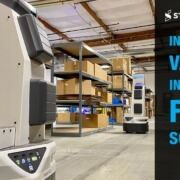Order fulfillment in today’s world is significantly different from even just a few years ago. With the rise of e-commerce, expectations for order fulfillment’s speed and accuracy make it hard for traditional warehouse operators to keep up.
In competing with the Amazons of the world, these traditional distribution centers are battling against now-slow fulfillment times, rising labor costs, and throughput challenges. Meeting those customer demands can be trying without introducing technology and dynamic solutions designed to meet those challenges head-on.
For those new to these emerging technologies, making that jump into automation can be scary. However, Fetch Robotics offers a line of products designed to assist with several operational variations without massive infrastructure investment.
They may not fully understand that there are introductory-level solutions available that allow incrementally beneficial solutions, many of which offer a return on investment relatively quickly. Plus, you do not have to deal with software integration or making a bunch of infrastructure changes. Instead, you can get a simple solution up and running quickly and easily. If you need something complicated or need a more comprehensive solution over time, these solutions can be more fully integrated to meet those needs.
Here are five ways that Fetch can incrementally add value to your operations:
- Zone Pick/Batch Picking: Autonomous mobile robots (AMRs) are great tools to handle material movement, especially in zone or batch picking scenarios. They can physically move products from the pick area to another point in the process – perhaps to a conveyor or packing area. This usage saves your labor force from the physical toll of handling the material and traveling required, which also cuts down on travel time and allows your fulfillment to happen quicker.
- Each Picking / Case Picking: People typically do not think of AMRs when handling each pick or case pick scenarios. However, that is a misconception. In fact, with the rise of e-commerce, these AMRs can similarly speed up the fulfillment process. Because each picking tends to associate itself with higher labor costs, integrating AMRs can be a great way to keep those labor costs down by reducing the distance traveled and the wear-and-tear on your workers.
- Adaptability: As consumer demand continues to change, distribution centers that rely on heavy-duty pick modules or conveyors can fall behind. Why? Because they cannot change their processes quickly enough to meet those changes, the infrastructure they have constructed is too limiting and costly to move. Fetch Solutions allow your operations to quickly and easily adjust as needed.
- Scalability: With a Fetch AMR solution, you can scale your automation quickly and simply by adding robots. Because workflows are developed within the FetchCore cloud operating platform, they can be programmed within just a few minutes. By adding more robots, you can increase your throughput as needed, allowing you to respond to demand changes as quickly as you need to.
- Flexibility: Because these AMRs run on cloud-based software, they can be re-programmed at any point from anywhere that has an internet connection. That means, should your needs change – for instance, a new pick point needs to be added or removed, you can set those points without needing to re-program or re-map an entire facility.
Let’s Talk this Through
These solutions are not solely limited to support e-commerce, either. AMRs can support a wide variety of material handling needs and distribution concepts. Their adaptability, scalability, and flexibility can be explicitly designed to suit any number of needs.
If this is all new to you, know that we are here to help. Our team has years of experience in integrating these systems to fit a variety of industry models. Give us a call today, and we can talk about what challenges you face and determine the right course of action to give your organization that incremental value needed when you are first integrating dynamic solutions.


